


Taking Back What's Ours
The Struggle of the Townspeople of Venustiano Carranza, Chiapas
By Alex Mensing
Special to The Narco News Bulletin
May 22, 2014
The morning sun was just above the horizon when San Cristóbal’s cobblestone streets and colonial houses gave way to crumbling pavement and deep green cornfields. Our combi, a small minibus bursting with passengers, wound its way downwards out of the highlands of Chiapas, down into the warmer climate of the lowland valleys. Eliezer’s eyes lit up as he told me the story of the community we were going to visit, his hands gesturing this way and that, grasping for words, and then for his seat as our combi lurched onward through the countryside.
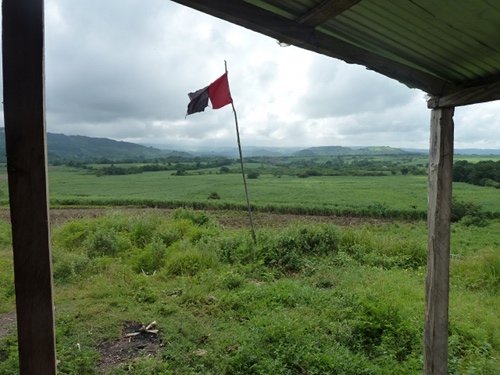 Recovered lands, some still in process of regularization, as seen from a lookout post where OCEZ-RC members take turns watching over strategic points. DR Alex Mensing 2014 |
Eliezer’s lowered his voice as we boarded our final combi explaining that it is best to be discrete in Venustiano Carranza – the municipality (analagous to a county in the US) in which López Hernández is located. The battle for control of the area’s fertile lands is far from over, and the OCEZ-RC has its enemies. Just a few months earlier several people had been killed in the municipal capital. Rumors and accusations abounded. As we walked the last bit of dirt road and passed the community checkpoint, Eliezer relaxed and our excitement set in. “There should be a group waiting for you,” he said. “There’s a lot to talk about.”
Through decade after decade of defending their land, the peasant and indigenous community of Venustiano Carranza municipality has learned many lessons about organizing to achieve their goals. During two visits to López Hernández, members of the OCEZ-RC generously shared with me their history, their strategy and their community. This article intends to pass along some of their lessons and principles, explaining how the OCEZ-RC works for social change and recounting a few of the historical experiences that led them there.
A Lineage of Oppression
“[Our parents] also instilled in us that we had to work for the patrón,
so that we, too, would serve the sons of the wealthy”
As OCEZ-RC member Uber looks out over the landscape around López Hernández, he sees much more than a patchwork of green and yellow fields. His family’s history, which is a history full of hardship, oppression and struggle, is inextricably tied to the valleys and hills that surround them. As he showed me that landscape, Uber could see what I could not – the invisible lines that mark the boundaries between private and communal property, between one large landholding and the next. The lines that establish ownership and lack thereof, that say whether the corn you harvest will feed your family or pay your debt. And not only that, but Uber could see lines that have long since faded from the map. He knows that what now belongs to his community once belonged to a cacique (a local strongman who controls both political and economic power), and to the cacique’s father before him, but that all of it, as far as the eye can see, once belonged to his ancestors.
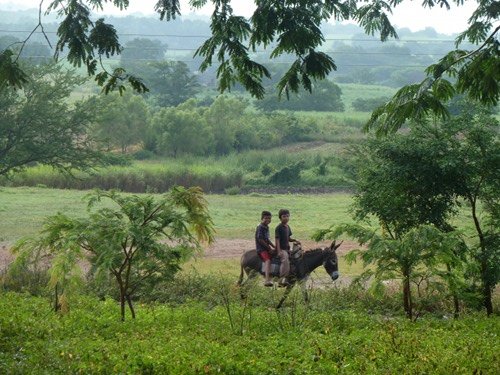 Boys ride a donkey through land recovered from a cacique by the OCEZ-RC.DR Alex Mensing 2014 |
Uber’s father Francisco grew up on a ranch owned by Fernando Borraz, a local cacique, who was very demanding and paid very little. “Work if you want. If not, you can go,” Francisco recalls him saying. “And with the need for work, what could a peasant do? Just bow his head and keep working.”
The work that Francisco’s father did was the same as his father before him. Franscisco’s grandparents were peones acasillados – peasants who worked in the fields for a plantation or ranch owner in exchange for a place to live and grow crops to feed their family, though a set quantity of grain was due to the landowner at harvest time as rent. They wore traditional dress and spoke tzotzil, the indigenous language of their ancestors. Their children must have learned much of it by listening, but they never taught it to Francisco.
Young Francisco’s landlord or patrón was the grandchild of mapaches – members of the powerful landowning elite in Chiapas who joined forces after the Mexican Revolution to prevent the implementation of agrarian and labor reforms in their state. Their rebel army, which used their own peasants as soldiers, expelled the revolutionary forces. To gain Chiapas’ loyalty and achieve national unity, the Mexican government finally gave in and allowed the mapaches to maintain their landholdings and indentured servants. Landlords who had participated in the counter-revolution were rewarded by local officials with more land grants, often at the expense of communal lands.
It was impossible for Francisco’s father to grow enough corn on their allotted land to pay for rent and to raise his family. The patrón would lend them money or corn, but would add it to a work debt. “Instead of a person’s debt decreasing, they would get buried more and more by it,” said Francisco. “Their harvest was no longer enough.” Francisco’s mother began to raise pigs on the side to raise extra money.
Despite this situation, Francisco’s parents believed strongly in respecting their patrón and his family. He remembers how once, when the patrón’s son stole his brother’s slingshot and made fun of him because he knew he could get away with it, Francisco’s brother insulted his mother. “What did my dad do when we got home? He grabbed the whip and he let my brother have it,” Francisco remembers. “And he really gave it to him. Because he disrespected the patrón’s son.” Their father never confronted the landlords about their son’s behavior or their unwillingness to discipline him for it. “What humilliation,” said Francisco, sounding almost surprised at to be telling such a story about his past, as if it were a bad dream. “We were definitely blind to that.”
Francisco’s experiences remind me of something that another OCEZ-RC member, Don Chema, had explained about the difficulties of organizing in Chiapas. “You see, the domination of our people wasn’t just physical repression,” he explained.
It was also the brainwashing that the friars came to do after the Spanish invasion. […] In the bible, in the texts and all that, it always says that you have to respect the one who has. If he has, it’s because god gave him that virtue, that luck. And whoever doesn’t have, it’s because god also wanted that it to be that way, that he not have. And he shouldn’t envy the one who has. That was the argument so that the people would accept their reality. Because it was an order from god.”
Private landowners in the Venustiano Carranza region benefited from this historic domination of the indigenous peoples by taking over their communal lands. Such lands are at the heart of land disputes in Chiapas. When members of the OCEZ-RC say they are fighting for “communal land,” though, it is important to understand that this is not simply a reference to a shared vision of community members cooperating on the land. Communal land is a constitutionally established category of land ownership in Mexico. Its history dates back to pre-Hispanic times and was even incorporated into early colonial rule.
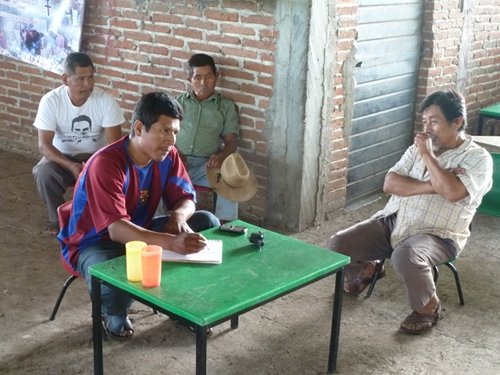 Uber takes notes as OCEZ-RC members prepare a communiqué announcing an intermittent highway blockade the following day. DR Alex Mensing 2014 |
The reformed Article 27 states that if two thirds of the title holders of a communally-owned property agree, the land is broken up and individual titles are granted. The opening up of privatization and cutting off of peasant-benefiting expropriation were both key policies in laying the groundwork for the passage of the North American Free Trade Agreement. After all, why would the US want to open Mexico up if it was not for sale?
Collective land ownership is a fundamental element of the OCEZ-RC. Communal land use and stewardship have their origins in indigenous land practices, but today both traditions are used as tactics of resistance against privatization and impoverishment. By the time Francisco’s parents were raising a family under the oppressive patronage of a cacique, much of the indigenous community’s original communal land had was under the control of ranchers and plantations.
When Uber was born, his father was working on a ranch owned by Fernando Borraz’s brother, Alejandro Borraz. Uber started working on the ranch when he was twelve. On weekends, when the landlord’s children visited, Uber and his brother would saddle up horses for them and take them for a joy ride through the countryside, the young peasants guiding on foot and the landowners on horseback. That was not to make extra money, though. That was because the landlord said so. After leaving the humble rural elementary school, Uber tells me, “there was no other path for me than to go work and serve the same patrón, to obey his orders. The same inheritance that our parents and grandparents had taught us and left for us.”
Building Grassroots Support for Overthrowing the Patrón
“If the original title says that the land is ours, that it isn’t a gift from the government,
because our ancestors bought it with their gold reserves,
why should we keep asking the government for it?”
In 1999, not many years after Uber started working, the first step of OCEZ-RC’s organizing process began in the village of Laguna Verde, where Francisco and Uber’s family lived. 52 families associated with the leadership of Casa del Pueblo – the peasant organization of communal land owners in Venustiano Carranza, where OCEZ originated – were kicked out after a paramilitary group forcibly took control of their headquarters. (It was this expulsion that led to the establishment of the independent OCEZ-RC.) After the families managed to settle on a piece of land that was formerly owned by a cacique, they came to realize the extreme prevalence of landless peasants in the area and decided to begin organizing locals to fight for land. This effort was a natural outgrowth of the group’s central principle of solidarity. The land they decided to fight for is half an hour’s walk from where Uber and Francisco told me the history of OCEZ.
From the perspective of Uber’s family at the time, OCEZ-RC’s takeover of the nearby landowner’s ranch was nothing but bad news. They worried that the ranch they worked on might suffer the same fate and cause them to lose their jobs. When OCEZ-RC began meeting with local indigenous people about organizing and recuperating their ancestral lands, heads of families responded negatively. “How could I take my pátron’s land? How could I go against my patrón? All of the worst,” Uber recognizes in hindsight. “If we do as you say, they’ll throw us in jail because of our patrón, or they’ll have us killed, or they’ll fire us from our work.”
So what did the OCEZ-RC organizers do? They spoke with the young people. They held meetings, but not just meetings. They held parties and organized sports events. And they talked to them about the history of the land they lived on. Young Uber did not want anything to do with this supposed organization, he was a shy and quiet person. But when he found out that his cousins were involved, it piqued his interest.
“One time my cousin Carmelo said to me, ‘you know what, cousin, on Saturday there’s a meeting in the community of Laguna Verde, and it is the second meeting we’re having about the attempt to form a group to petition for some lands.’ So he told me that, like on a Wednesday. So since my dad had already mentioned that there was this group, I went on Saturday and saw that there were people gathered there and there were men, there were young people. And there I was, afraid, embarrassed. I joined their meeting and I asked to speak. And I remember that I told them, well, look, I found out about your group, and, well, I also want to join the struggle that you’re having to see if we can manage to get a piece of land.”
That’s how many young people got involved, recalled Uber. “And each of us had the task of speaking with our parents, of telling them that if they didn’t want to, at least they should give us the opportunity to have that group and try to recuperate our lands.”
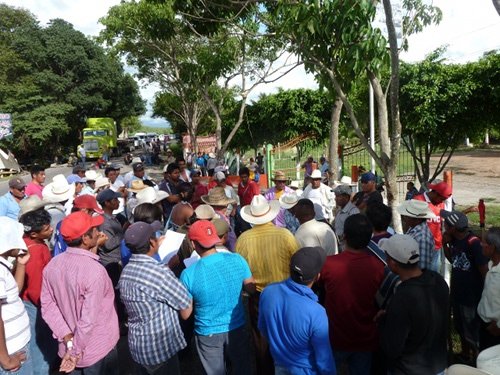 OCEZ-RC members meet during an intermittent highway blockade to discuss logistics. DR Alex Mensing 2014 |
They started meeting in 2001 and formed the Executive Agrarian Committee of Santa María de Asunción Laguna Verde, presenting themselves as landless peasants to the state government. They submitted a petition for farmland, indicating a nearby ranch and requesting that the government pay the owner and turn it over to them. This OCEZ tactic is based on the fact that the original 1917 Mexican Constitution stated that a group of landless peasant families had the right to petition for the establishment of an ejido, or collective land. Claimants had the right to a minimum acreage, which was to be granted from available public lands or through expropriation. In fact, the constitutional reform of 1992 that opened communal lands to privatization declared the end of agrarian reform, eliminating this constitutional right. Nevertheless, the OCEZ-RC continues to pressure the state government, demanding access to land that was taken from them illegally by the caciques.
Even once the peasants of Laguna Verde had an official organization it was difficult to get them involved outside of meetings. “At that time, when the group got organized and called for a march, suddenly they weren’t there. [The members] didn’t exist, they dispersed,” said Uber. “And they said, no, I mean how could we go march? How could we make trouble for our patrón, the one who feeds us?” The cacique who owned the ranch where Uber and his friends worked lived in the municipal capital along the main street where they would hold demonstrations, and when they passed his house they would hide their faces for fear of reprisal.
Uber eventually took on a role as group secretary, despite initial hesitation. He was encouraged to take on the role by others, though, who told him that part of the OCEZ-RC is that everyone should serve the group at some point. Participating peasants slowly learned to speak in front of others, to write press releases, to communicate with government officials, to understand their history, and to organize public displays of support. Besides being traditional elements of local indigenous culture, collective leadership and decision-making protect the organization against the dangers of corruption, incarceration and assassination. Such dangers and their association with individualistic leadership are best understood by looking into the region’s history.
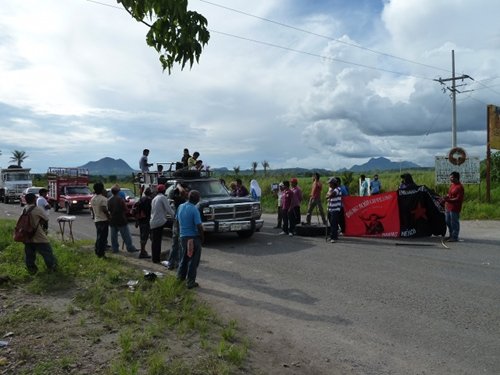 OCEZ-RC members perform an intermittent highway blockade to pressure the government to make good on its promises to regularize lands held by OCEZ-RC communities and provide development support. DR Alex Mensing 2014 |
In the 1960s and 70s, the peasant community began to grow increasingly impatient with big ranchers’ illegal use of communal land, so they increased their efforts to take back the land. In response, the caciques increased violent repression, targeting community leaders because they posed an obvious threat to caciques’ power. Hired gunmen shot the community’s Committee representative, Córdoba Ayar, in 1966. His successor was killed in 1970, and the next in 1971. This repression remains in the modern OCEZ-RC’s collective memory, as was illustrated to me by an experience with Eliezer, the man who had taken me to López Hernández.
He took me on a tour of a nearby OCEZ-RC community and showed me the building where the former landowner (who illegally occupied communal lands) had lived before they recuperated it. As we stood talking about the building, a song played loudly through the tinny, strained speakers of his cell phone. The words of the corrido – a traditional Mexican song genre – told the story of Bartolomé Martínez Villatoro, who became the Communal Goods Committee representative in 1972 and survived several assassination attempts and eight months in prison before falling victim to the caciques in 1975.
“He was a peasant man
who helped the people.
He got rid of large landholdings
By the president’s orders.
He had many enemies
Caciques and hacienda owners,
On his way to Teopisca
They left him lying there.
Three discharges were heard
of an M-1 machine gun,
and they still shouted
‘get him!’ One by one.”
After that 1975 assassination the indigenous peasant community established a committee made up of a dozen people, rather than just one, including both experienced members and new ones who would learn from the others. To this day, decisions are made in community assemblies and meetings of representatives. “And since there’s no leader, anybody can take on a leadership role,” says Don Chema, laughing wryly at the tragic reality he has come to know so well. “That’s why the organization keeps surviving. Anyone can be arrested, assassinated, bought out, the organization doesn’t run out. Others follow.”
Returning to the early 2000s, it took three or four years for the group that Uber had joined to grow to sixty members and their families. During that time they continued constantly petitioned the government and held public demonstrations. Eventually, a consensus grew that they needed to take further action. Their land petition had been ignored for four years by the government, along with their public demonstrations. Uber said he was not the only one who for a long time had been quietly thinking to himself, “Why so much talk? Why don’t we just occupy the ranch?”
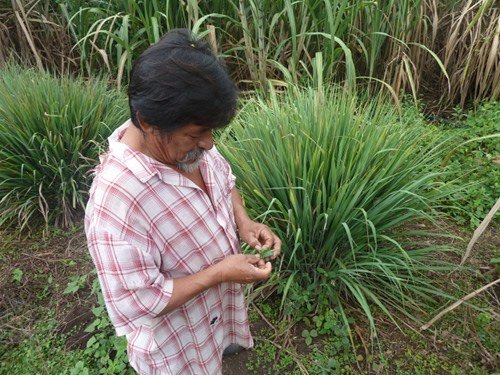 Don Chema harvests leaves for a tea from his herb garden. DR Alex Mensing 2014 |
It took more than forty years to learn this lesson for the first time. The indigenous community of Venustiano Carranza filed appropriate petitions with the federal government in 1933. In 1976 their demands remained unresolved by the government. That year 200 community members armed themselves and began running wealthy ranchers and their hired gunmen off of communal land. The government responded by sending the army, which resulted in an 8-hour battle, several deaths, and the imprisonment of the entire community council, but they learned an important lesson. When asked how it was that peasants finally came to that extreme, Don Chema throws up his hands, and says “what else could we have done!?”
“It cost a lot, but since we had already gone through the entire legal process, there weren’t any arguments left. […] We had the title in our hands. The original one, which says the land is the property of Communal Goods. On the other hand, the Government of the Republic confirmed that the community owns 50,152 hectares of land. So we said, ‘well, what are we waiting for? We aren’t going to wait for the President of the Republic to come distribute it, or to kick them out without doing it ourselves. We aren’t going to wait for god to come down and kick those people out. That is how they became convinced. And when we took the action, everyone was aware that in that action anyone who went could lose their life.”
Taking Back What’s Theirs
“The rich man was beating us down, so we had to find a way to fight, too,
to take possession of the land.”
So it was that after four years of organizing, on the night of April 25th, 2005, sixty families of landless farm day laborers and indentured sharecroppers took over a ranch. Alejandro Castañeda Borraz, the owner of the ranch, arrived in the morning to see the entrance of his ranch blocked by peasants, many of them his employees, wielding banners that said “RESPECT LAND OCCUPATIONS” and “THE LAND BELONGS TO THOSE WHO WORK IT.” He asked them just what they thought they were doing, reminding them that the land belonged to him, and that they owed their employment and means of livelihood to his patronage, playing on the old dynamic of cacique-peasant relations.
But the peasants knew what to say. Uber says that since they had four years of orientation and discussion under their belts, they said to the landowner:
“The thing is, say what you will, but here there is a reason that backs us up rightfully. You know that during the time of the mapaches, of those people who came to take over large extensions of land, that your grandparents were among those who came to take over the land, even though they knew that it belonged to a group of peasants, to our grandparents. They didn’t care. Our grandparents rebelled and you ran them out, and some stayed as your slaves. So don’t come to tell us that because of a document the land is yours, because you set that up in agreement with the authorities.”
When Castañeda Borraz heard that, recalls Uber, his posture changed. He offered to sell it to them, laughing, if they had the money that it was worth. “The government is the one who is going to pay for it,” they responded. “Because you know how you played your tricks back then, so if you want to charge anyone, charge the government.” The OCEZ-RC members offered to help pressure for a negotiating table so that the government would compensate the landowner.
The landowner left, saying he had to talk to his brother about the price of the land. When he returned, though, he returned with about 1,000 members of the law enforcement. The official who spoke to them said that this was unacceptable, but that they would open up a case for them if they left peacefully. Under the circumstances, with women, children, and the elderly present, the families decided to retreat.
For the next four years, the OCEZ-RC members of Laguna Verde pressured the government to grant them land. But now that the landowner and government saw them as a serious threat, they lived under constant fear. Uber stopped working at the ranch. Their homes were searched. The landowner vandalized his own fields and buildings to frame the land-petitioners of crimes, and the police obliged with arrest warrants. The rancher even had several of his ranch-hands murdered. The subsequent hunt for the supposed perpetrators forced many of the organization’s members to flee and hide in the mountains for several months.
It was then that the community decided they could not continue like this. With one hand, the landowner and government constantly promised imminent resolution to their problems. With the other hand, it sought to discourage, divide and repress the organization. They decided to organize another land occupation, but this time with more support. “On July 14th of 2009,” Uber proudly tells me, “we took possession of the ranches” with the presence of all the organization’s comrades.
“Now the government saw it wasn’t just the members of the group, rather it was the whole organization that was taking control of the land to recover them. And we had a permanent denunciation by a committee in San Cristóbal de las Casas, taking over the State Human Rights Council.”
It took another week of occupation and discussion, but in the end the problem was too acute and too well-known for the government to avoid any longer. The land where Uber and Francisco sat as they told their story, the land they now call their own, where they and their neighbors grow corn and beans and squash for their families, is the same land on which they and so many of their ancestors were subjugated to the exploitation of a few powerful landowners.
Conclusion to an Unfinished Story
“The struggle is permanent.”
As many of the community members in López Hernández say, the struggle is far from over. Once they have managed to take back a piece of land for themselves, they fight for better services for their village, for better lives for their children. They stand in solidarity with others who have not yet taken back a piece of land, just as the OCEZ-RC stood in solidarity with the community of Laguna Verde during their struggle.
Some people are taken aback by the OCEZ-RC strategy’s combination of government negotiation and civil disobedience. But their tactics are what they have found to work for them. Their tactics allow them to achieve the sorts of step-by-step gains that keep peasant families hopeful and motivated. Don Chema, for example, does not see this as a conflict of interests or as some sort of ideological impurity. When he explains how he sees it, he points out that legal or illegal, government-provided or community-provided, their main interest is in justice and dignity.
“What do we argue for?,” asks Don Chema. “Justice. Because the law is one thing, and social justice is another. What is social justice, which also exists in decrees? That every Mexican citizen has the right to live with dignity through their work.”
Lea Ud. el Artículo en Español
- The Fund for Authentic Journalism
For more Narco News, click here.




